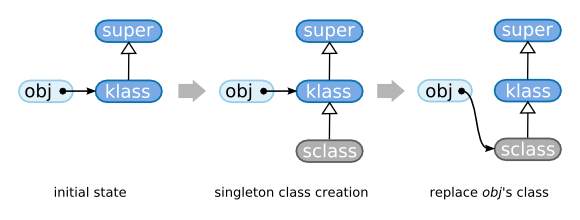
Figure 1:
rb_singleton_classIn this chapter, we’ll see the details of the data structures created for classes and modules.
First, I’d like to have a look at how Ruby classes are defined at the C level. This chapter investigates almost only particular cases, so I’d like you to know first the way used most often.
The main API to define classes and modules consists of the following 6 functions:
rb_define_class()rb_define_class_under()rb_define_module()rb_define_module_under()rb_define_method()rb_define_singleton_method()There are a few other versions of these functions, but the extension libraries and even most of the core library is defined using just this API. I’ll introduce to you these functions one by one.
rb_define_class() defines a class at the top-level. Let’s take the
Ruby array class, Array, as an example.
Array class definition
19 VALUE rb_cArray;
1809 void
1810 Init_Array()
1811 {
1812 rb_cArray = rb_define_class("Array", rb_cObject);
(array.c)
rb_cObject and rb_cArray correspond respectively to Object and
Array at the Ruby level. The added prefix rb shows that it belongs
to ruby and the c that it is a class object. These naming rules
are used everywhere in ruby.
This call to rb_define_class() allows to define Array that
inherits from Object. At the same time as rb_define_class() creates
the class object, it also defines the constant. That means that after this
you can already access Array from a Ruby program. It corresponds to
the following Ruby program:
class Array < Object
I’d like you to note the fact that there is no end. It was
written like this on purpose. It is because with rb_define_class()
the body of the class has not been executed.
After that, there’s rb_define_class_under(). This function defines a
class nested in an other class or module. This time the example is
what is returned by stat(2), File::Stat.
File::Stat
78 VALUE rb_cFile;
80 static VALUE rb_cStat;
2581 rb_cFile = rb_define_class("File", rb_cIO);
2674 rb_cStat = rb_define_class_under(rb_cFile, "Stat", rb_cObject);
(file.c)
This code corresponds to the following Ruby program;
class File < IO class Stat < Object
This time again I omitted the end on purpose.
rb_define_module() is simple so let’s end this quickly.
Enumerable
17 VALUE rb_mEnumerable;
492 rb_mEnumerable = rb_define_module("Enumerable");
(enum.c)
The m in the beginning of rb_mEnumerable is similar to the c for
classes: it shows that it is a module. The corresponding Ruby program
is:
module Enumerable
rb_define_module_under() is not used much so we’ll skip it.
This time the function is the one for defining methods,
rb_define_method(). It’s used very often. We’ll take once again an
example from Array.
Array#to_s
1818 rb_define_method(rb_cArray, "to_s", rb_ary_to_s, 0); (array.c)
With this the to_s method is defined in Array. The method body is
given by a function pointer (rb_ary_to_s). The fourth parameter is
the number of parameters taken by the method. As to_s does not take
any parameters, it’s 0. If we write the corresponding Ruby program,
we’ll have this:
class Array < Object
def to_s
# content of rb_ary_to_s()
end
end
Of course the class part is not included in rb_define_method() and
only the def part is accurate. But if there is no class part, it
will look like the method is defined like a function, so I also wrote
the enclosing class part.
One more example, this time taking a parameter:
▼ Definition ofArray#concat
1835 rb_define_method(rb_cArray, "concat", rb_ary_concat, 1); (array.c)
The class for the definition is rb_cArray
(Array), the method name is concat, its body
is rb_ary_concat() and the number of parameters is 1. It
corresponds to writing the corresponding Ruby program:
class Array < Object
def concat( str )
# content of rb_ary_concat()
end
end
We can define methods that are specific to an instance of an
object. They are called singleton methods. As I used File.unlink as
an example in chapter 1 “Ruby language minimum”, I first wanted to
show it here, but for a particular reason we’ll look at File.link
instead.
File.link
2624 rb_define_singleton_method(rb_cFile, "link", rb_file_s_link, 2); (file.c)
It’s used like rb_define_method(). The only difference is that here
the first parameter is just the object where the method is
defined. In this case, it’s defined in rb_cFile.
Being able to make definitions like before is great, but where
are these functions called from, and by what means are they executed?
These definitions are grouped in functions named Init_xxxx(). For
instance, for Array a function Init_Array() like this has been
made:
Init_Array
1809 void
1810 Init_Array()
1811 {
1812 rb_cArray = rb_define_class("Array", rb_cObject);
1813 rb_include_module(rb_cArray, rb_mEnumerable);
1814
1815 rb_define_singleton_method(rb_cArray, "allocate",
rb_ary_s_alloc, 0);
1816 rb_define_singleton_method(rb_cArray, "[]", rb_ary_s_create, -1);
1817 rb_define_method(rb_cArray, "initialize", rb_ary_initialize, -1);
1818 rb_define_method(rb_cArray, "to_s", rb_ary_to_s, 0);
1819 rb_define_method(rb_cArray, "inspect", rb_ary_inspect, 0);
1820 rb_define_method(rb_cArray, "to_a", rb_ary_to_a, 0);
1821 rb_define_method(rb_cArray, "to_ary", rb_ary_to_a, 0);
1822 rb_define_method(rb_cArray, "frozen?", rb_ary_frozen_p, 0);
(array.c)
The Init for the built-in functions are explicitely called during
the startup of ruby. This is done in inits.c.
rb_call_inits()
47 void
48 rb_call_inits()
49 {
50 Init_sym();
51 Init_var_tables();
52 Init_Object();
53 Init_Comparable();
54 Init_Enumerable();
55 Init_Precision();
56 Init_eval();
57 Init_String();
58 Init_Exception();
59 Init_Thread();
60 Init_Numeric();
61 Init_Bignum();
62 Init_Array();
(inits.c)
This way, Init_Array() is called properly.
That explains it for built-in libraries, but what about extension libraries? In fact, for extension libraries the convention is the same. Take the following code:
require "myextension"
With this, if the loaded extension library is myextension.so, at
load time, the (extern) function named Init_myextension() is
called. How they are called is beyond the scope of this chapter. For
that, you should read the chapter 18 “Load”. Here we’ll just end this
with an example of Init.
The following example is from stringio, an extension library
provided with ruby, that is to say not from a built-in library.
Init_stringio() (beginning)
895 void
896 Init_stringio()
897 {
898 VALUE StringIO = rb_define_class("StringIO", rb_cData);
899 rb_define_singleton_method(StringIO, "allocate",
strio_s_allocate, 0);
900 rb_define_singleton_method(StringIO, "open", strio_s_open, -1);
901 rb_define_method(StringIO, "initialize", strio_initialize, -1);
902 rb_enable_super(StringIO, "initialize");
903 rb_define_method(StringIO, "become", strio_become, 1);
904 rb_define_method(StringIO, "reopen", strio_reopen, -1);
(ext/stringio/stringio.c)
rb_define_singleton_method()You should now be able to more or less understand how normal methods are
defined. Somehow making the body of the method, then registering it
in m_tbl will do. But what about singleton methods? We’ll now look
into the way singleton methods are defined.
rb_define_singleton_method()
721 void
722 rb_define_singleton_method(obj, name, func, argc)
723 VALUE obj;
724 const char *name;
725 VALUE (*func)();
726 int argc;
727 {
728 rb_define_method(rb_singleton_class(obj), name, func, argc);
729 }
(class.c)
As I explained, rb_define_method() is a function used to define
normal methods, so the difference from normal methods is only
rb_singleton_class(). But what on earth are singleton classes?
In brief, singleton classes are virtual classes that are only used to execute singleton methods. Singleton methods are functions defined in singleton classes. Classes themselves are in the first place (in a way) the “implementation” to link objects and methods, but singleton classes are even more on the implementation side. In the Ruby language way, they are not formally included, and don’t appear much at the Ruby level.
rb_singleton_class()Well, let’s confirm what the singleton classes are made of. It’s too simple to each time just show you the code of function so this time I’ll use a new weapon, a call graph.
rb_define_singleton_method
rb_define_method
rb_singleton_class
SPECIAL_SINGLETON
rb_make_metaclass
rb_class_boot
rb_singleton_class_attached
Call graphs are graphs showing calling relationships among functions (or more generally procedures). The call graphs showing all the calls written in the source code are called static call graphs. The ones expressing only the calls done during an execution are called dynamic call graphs.
This diagram is a static call graph and the indentation expresses
which function calls which one. For instance,
rb_define_singleton_method() calls rb_define_method() and
rb_singleton_class(). And this rb_singleton_class() itself calls
SPECIAL_SINGLETON() and rb_make_metaclass().
Let’s go back to the code. When looking at the call graph, you can see
that the calls made by rb_singleton_class() go very deep. Until now
all call levels were shallow, so we could simply look at the functions
without getting too lost. But at this depth, I easily forget
what is going on in the code. That’s why in those situations I check
the call graph to have a better understanding. This time, we’ll decode
in parallel what the procedures below rb_singleton_class() do. The
two points to look out for are the following ones:
Singleton classes are special classes: they’re basically the same as normal classes, but there are a few differences. We can say that finding these differences is explaining concretely singleton classes.
What should we do to find them? We should find the differences between
the function creating normal classes and the one creating singleton
classes. For this, we have to find the function for creating normal
classes. That is as normal classes can be defined by
rb_define_class(), it must call in a way or another a function to
create normal classes. For the moment, we’ll not look at the content
of rb_define_class() itself. I have some reasons to be interested in
something that’s deeper. That’s why we will first look at the call
graph of rb_define_class().
rb_define_class
rb_class_inherited
rb_define_class_id
rb_class_new
rb_class_boot
rb_make_metaclass
rb_class_boot
rb_singleton_class_attached
I’m interested by rb_class_new(). Doesn’t this name means it creates
a new class? Let’s confirm that.
rb_class_new()
37 VALUE
38 rb_class_new(super)
39 VALUE super;
40 {
41 Check_Type(super, T_CLASS);
42 if (super == rb_cClass) {
43 rb_raise(rb_eTypeError, "can't make subclass of Class");
44 }
45 if (FL_TEST(super, FL_SINGLETON)) {
46 rb_raise(rb_eTypeError, "can't make subclass of virtual class");
47 }
48 return rb_class_boot(super);
49 }
(class.c)
Check_Type() is checks the type of object structure, so we can
ignore it. rb_raise() is error handling so we can ignore it. Only
rb_class_boot() remains. So let’s look at it.
rb_class_boot()
21 VALUE
22 rb_class_boot(super)
23 VALUE super;
24 {
25 NEWOBJ(klass, struct RClass); /* allocates struct RClass */
26 OBJSETUP(klass, rb_cClass, T_CLASS); /* initialization of the RBasic part */
27
28 klass->super = super; /* (A) */
29 klass->iv_tbl = 0;
30 klass->m_tbl = 0;
31 klass->m_tbl = st_init_numtable();
32
33 OBJ_INFECT(klass, super);
34 return (VALUE)klass;
35 }
(class.c)
NEWOBJ() and OBJSETUP() are fixed expressions used when creating
Ruby objects that possess one of the internal structure types (struct
Rxxxx). They are both macros. In NEWOBJ(), struct RClass is
created and the pointer is put in its first parameter klass. In
OBJSETUP(), the struct RBasic member of the RClass (and thus
basic.klass and basic.flags) is initialized.
OBJ_INFECT() is a macro related to security. From now on, we’ll
ignore it.
At (A), the super member of klassis set to the super
parameter. It looks like rb_class_boot() is a function that creates
a class inheriting from super.
So, as rb_class_boot() is a function that creates a class,
what does rb_class_new() is very similar.
Then, let’s once more look at rb_singleton_class()’s call graph:
rb_singleton_class
SPECIAL_SINGLETON
rb_make_metaclass
rb_class_boot
rb_singleton_class_attached
Here also rb_class_boot() is called. So up to that point, it’s the
same as in normal classes. What’s going on after is what’s different
between normal classes and singleton classes, in other words the
characteristics of singleton classes. If you everything’s clear so
far, we just need to read rb_singleton_class() and
rb_make_metaclass().
rb_singleton_class()rb_singleton_class() is a little long so we’ll first remove its
non-essential parts.
rb_singleton_class()
678 #define SPECIAL_SINGLETON(x,c) do {\
679 if (obj == (x)) {\
680 return c;\
681 }\
682 } while (0)
684 VALUE
685 rb_singleton_class(obj)
686 VALUE obj;
687 {
688 VALUE klass;
689
690 if (FIXNUM_P(obj) || SYMBOL_P(obj)) {
691 rb_raise(rb_eTypeError, "can't define singleton");
692 }
693 if (rb_special_const_p(obj)) {
694 SPECIAL_SINGLETON(Qnil, rb_cNilClass);
695 SPECIAL_SINGLETON(Qfalse, rb_cFalseClass);
696 SPECIAL_SINGLETON(Qtrue, rb_cTrueClass);
697 rb_bug("unknown immediate %ld", obj);
698 }
699
700 DEFER_INTS;
701 if (FL_TEST(RBASIC(obj)->klass, FL_SINGLETON) &&
702 (BUILTIN_TYPE(obj) == T_CLASS ||
703 rb_iv_get(RBASIC(obj)->klass, "__attached__") == obj)) {
704 klass = RBASIC(obj)->klass;
705 }
706 else {
707 klass = rb_make_metaclass(obj, RBASIC(obj)->klass);
708 }
709 if (OBJ_TAINTED(obj)) {
710 OBJ_TAINT(klass);
711 }
712 else {
713 FL_UNSET(klass, FL_TAINT);
714 }
715 if (OBJ_FROZEN(obj)) OBJ_FREEZE(klass);
716 ALLOW_INTS;
717
718 return klass;
719 }
(class.c)
The first and the second half are separated by a blank line. The first half handles a special case and the second half handles the general case. In other words, the second half is the trunk of the function. That’s why we’ll keep it for later and talk about the first half.
Everything that is handled in the first half are non-pointer VALUEs,
in other words objects without an existing C structure. First,
Fixnum and Symbol are explicitely picked. Then,
rb_special_const_p() is a function that returns true for non-pointer
VALUEs, so there only Qtrue, Qfalse and Qnil should get
caught. Other than that, there are no valid non-pointer value so a bug
is reported with rb_bug().
DEFER_INTS() and ALLOW_INTS() both end with the same INTS so you
should see a pair in them. That’s the case, and they are macros
related to signals. Because they are defined in rubysig.h, you can
guess that INTS is the abbreviation of interrupts. You can ignore
them.
rb_make_metaclass()rb_make_metaclass()
142 VALUE
143 rb_make_metaclass(obj, super)
144 VALUE obj, super;
145 {
146 VALUE klass = rb_class_boot(super);
147 FL_SET(klass, FL_SINGLETON);
148 RBASIC(obj)->klass = klass;
149 rb_singleton_class_attached(klass, obj);
150 if (BUILTIN_TYPE(obj) == T_CLASS) {
151 RBASIC(klass)->klass = klass;
152 if (FL_TEST(obj, FL_SINGLETON)) {
153 RCLASS(klass)->super =
RBASIC(rb_class_real(RCLASS(obj)->super))->klass;
154 }
155 }
156
157 return klass;
158 }
(class.c)
We already saw rb_class_boot(). It creates a (normal) class using
the super parameter as its superclass. After that, the
FL_SINGLETON of this class is set. This is clearly suspicious. The
name of the function makes us think that it is not the indication of
a singleton class.
Continuing the simplification process, furthermore as parameters,
return values, local variables are all VALUE, we can throw away the
declarations. That makes us able to compress to the following:
rb_singleton_class() rb_make_metaclass() (after compression)
rb_singleton_class(obj)
{
if (FL_TEST(RBASIC(obj)->klass, FL_SINGLETON) &&
(BUILTIN_TYPE(obj) == T_CLASS || BUILTIN_TYPE(obj) == T_MODULE) &&
rb_iv_get(RBASIC(obj)->klass, "__attached__") == obj) {
klass = RBASIC(obj)->klass;
}
else {
klass = rb_make_metaclass(obj, RBASIC(obj)->klass);
}
return klass;
}
rb_make_metaclass(obj, super)
{
klass = create a class with super as superclass;
FL_SET(klass, FL_SINGLETON);
RBASIC(obj)->klass = klass;
rb_singleton_class_attached(klass, obj);
if (BUILTIN_TYPE(obj) == T_CLASS) {
RBASIC(klass)->klass = klass;
if (FL_TEST(obj, FL_SINGLETON)) {
RCLASS(klass)->super =
RBASIC(rb_class_real(RCLASS(obj)->super))->klass;
}
}
return klass;
}
The condition of the if statement of rb_singleton_class() seems
quite complicated. However, this condition is not connected to the
mainstream of rb_make_metaclass() so we’ll see it later. Let’s first
think about what happens on the false branch of the if.
The BUILTIN_TYPE() of rb_make_metaclass() is similar to TYPE()
as it is a macro to get the structure type flag (T_xxxx). That means
this check in rb_make_metaclass means “if obj is a class”. For the
moment it’s better not to limit ourselves to obj being a class, so
we’ll remove it.
With these simplifications, we get the the following:
▼rb_singleton_class() rb_make_metaclass() (after recompression)
rb_singleton_class(obj)
{
klass = create a class with RBASIC(obj)->klass as superclass;
FL_SET(klass, FL_SINGLETON);
RBASIC(obj)->klass = klass;
return klass;
}
But there is still a quite hard to understand side to it. That’s
because klass is used too often. So let’s rename the klass
variable to sclass.
rb_singleton_class() rb_make_metaclass() (variable substitution)
rb_singleton_class(obj)
{
sclass = create a class with RBASIC(obj)->klass as superclass;
FL_SET(sclass, FL_SINGLETON);
RBASIC(obj)->klass = sclass;
return sclass;
}
Now it should be very easy to understand. To make it even simpler, I’ve represented what is done with a diagram (figure 1). In the horizontal direction is the “instance – class” relation, and in the vertical direction is inheritance (the superclasses are above).

Figure 1: rb_singleton_class
When comparing the first and last part of this diagram, you can
understand that sclass is inserted without changing the
structure. That’s all there is to singleton classes. In other words
the inheritance is increased one step. If a method is defined in a
singleton class, this construction allows the other instances of
klass to define completely different methods.
By the way, you must have seen that during the compression process,
the call to rb_singleton_class_attached() was stealthily
removed. Here:
rb_make_metaclass(obj, super)
{
klass = create a class with super as superclass;
FL_SET(klass, FL_SINGLETON);
RBASIC(obj)->klass = klass;
rb_singleton_class_attached(klass, obj); /* THIS */
Let’s have a look at what it does.
▼rb_singleton_class_attached()
130 void
131 rb_singleton_class_attached(klass, obj)
132 VALUE klass, obj;
133 {
134 if (FL_TEST(klass, FL_SINGLETON)) {
135 if (!RCLASS(klass)->iv_tbl) {
136 RCLASS(klass)->iv_tbl = st_init_numtable();
137 }
138 st_insert(RCLASS(klass)->iv_tbl,
rb_intern("__attached__"), obj);
139 }
140 }
(class.c)
If the FL_SINGLETON flag of klass is set… in other words if it’s a
singleton class, put the __attached__ → obj relation in the
instance variable table of klass (iv_tbl). That’s how it looks
like (in our case klass is always a singleton class… in other
words its FL_SINGLETON flag is always set).
__attached__ does not have the @ prefix, but it’s stored in the
instance variables table so it’s still an instance variable. Such an
instance variable can never be read at the Ruby level so it can be
used to keep values for the system’s exclusive use.
Let’s now think about the relationship between klass and
obj. klass is the singleton class of obj. In other words, this
“invisible” instance variable allows the singleton class to remember
the instance it was created from. Its value is used when the singleton
class is changed, notably to call hook methods on the instance
(i.e. obj). For example, when a method is added to a singleton
class, the obj’s singleton_method_added method is called. There is
no logical necessity to doing it, it was done because that’s how it
was defined in the language.
But is it really all right? Storing the instance in __attached__
will force one singleton class to have only one attached instance. For
example, by getting (in some way or an other) the singleton class and
calling new on it, won’t a singleton class end up having multiple
instances?
This cannot be done because the proper checks are done to prevent the creation of an instance of a singleton class.
Singleton classes are in the first place for singleton methods. Singleton methods are methods existing only on a particular object. If singleton classes could have multiple instances, there would the same as normal classes. That’s why they are forced to only have one instance.
We’ve done a lot, maybe made a real mayhem, so let’s finish and put everything in order with a summary.
What are singleton classes? They are classes that have the
FL_SINGLETON flag set and that can only have one instance.
What are singleton methods? They are methods defined in the singleton class of an object.
Even a class has a class, and it’s Class. And the class of Class
is again Class. We find ourselves in an infinite loop (figure 2).

Figure 2: Infinite loop of classes
Up to here it’s something we’ve already gone through. What’s going after that is the theme of this chapter. Why do classes have to make a loop?
First, in Ruby all data are objects. And classes are data so in Ruby they have to be objects.
As they are objects, they must answer to methods. And setting the rule “to answer to methods you must belong to a class” made processing easier. That’s where comes the need for a class to also have a class.
Let’s base ourselves on this and think about the way to implement it.
First, we can try first with the most naïve way, Class’s class is
ClassClass, ClassClass’s class is ClassClassClass..., chaining
classes of classes one by one. But whichever the way you look at it,
this can’t be implemented effectively. That’s why it’s common in
object oriented languages where classes are objects that Class’s
class is to Class itself, creating an endless virtual instance-class
relationship.
I’m repeating myself, but the fact that Class’s class is Class is
only to make the implementation easier, there’s nothing important in
this logic.
“Everything is an object” is often used as advertising statement when speaking about Ruby. And as a part of that, “Classes are also object!” also appears. But these expressions often go too far. When thinking about these sayings, we have to split them in two:
Talking about data or code makes a discussion much harder to understand. That’s why here we’ll restrict the meaning of “data” to “what can be put in variables in programs”.
Being able to manipulate classes from programs gives programs the ability to manipulate themselves. This is called reflection. It fits object oriented languages, and even more Ruby with the classes it has, to be able to directly manipulate classes.
Nevertheless, classes could be made available in a form that is not an object. For example, classes could be manipulated with function-style methods (functions defined at the top-level). However, as inside the interpreter there are data structures to represent the classes, it’s more natural in object oriented languages to make them available directly. And Ruby did this choice.
Furthermore, an objective in Ruby is for all data to be objects. That’s why it’s appropriate to make them objects.
By the way, there is a reason not linked to reflection why in Ruby classes had to be made objects. That is to be able to define methods independently from instances (what is called static methods in Java in C++).
And to implement static methods, another thing was necessary: singleton methods. By chain reaction, that also makes singleton classes necessary. Figure 3 shows these dependency relationships.
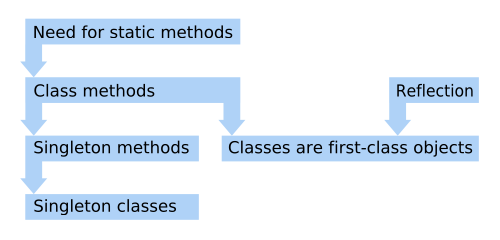
Figure 3: Requirements dependencies
In Ruby, singleton methods defined in a class are called class methods. However, their specification is a little strange. Why are class methods inherited?
class A
def A.test # defines a singleton method in A
puts("ok")
end
end
class B < A
end
B.test() # calls it
This can’t occur with singleton methods from objects that are not classes. In other words, classes are the only ones handled specially. In the following section we’ll see how class methods are inherited.
Assuming that class methods are inherited, where is this operation done? At class definition (creation)? At singleton method definition? Then let’s look at the code defining classes.
Class definition means of course rb_define_class(). Now
let’s take the call graph of this function.
rb_define_class
rb_class_inherited
rb_define_class_id
rb_class_new
rb_class_boot
rb_make_metaclass
rb_class_boot
rb_singleton_class_attached
If you’re wondering where you’ve seen it before, we looked at it in
the previous section. At that time you did not see it but if you look
closely, why does rb_make_metaclass() appear? As we saw before, this
function introduces a singleton class. This is very suspicious. Why is
this called even if we are not defining a singleton function?
Furthermore, why is the lower level rb_make_metaclass() used instead
of rb_singleton_class()? It looks like we have to check these
surroundings again.
rb_define_class_id()Let’s first start our reading with its caller, rb_define_class_id().
rb_define_class_id()
160 VALUE
161 rb_define_class_id(id, super)
162 ID id;
163 VALUE super;
164 {
165 VALUE klass;
166
167 if (!super) super = rb_cObject;
168 klass = rb_class_new(super);
169 rb_name_class(klass, id);
170 rb_make_metaclass(klass, RBASIC(super)->klass);
171
172 return klass;
173 }
(class.c)
rb_class_new() was a function that creates a class with super as
its superclass. rb_name_class()’s name means it names a class, but
for the moment we do note care about names so we’ll skip it. After
that there’s the rb_make_metaclass() in question. I’m concerned by
the fact that when called from rb_singleton_class(), the parameters
were different. Last time was like this:
rb_make_metaclass(obj, RBASIC(obj)->klass);
But this time is like this:
rb_make_metaclass(klass, RBASIC(super)->klass);
So as you can see it’s slightly different. How do the results change
depending on that? Let’s have once again a look at a simplified
rb_make_metaclass().
rb_make_metaclass (once more)rb_make_metaclass (after first compression)
rb_make_metaclass(obj, super)
{
klass = create a class with super as superclass;
FL_SET(klass, FL_SINGLETON);
RBASIC(obj)->klass = klass;
rb_singleton_class_attached(klass, obj);
if (BUILTIN_TYPE(obj) == T_CLASS) {
RBASIC(klass)->klass = klass;
if (FL_TEST(obj, FL_SINGLETON)) {
RCLASS(klass)->super =
RBASIC(rb_class_real(RCLASS(obj)->super))->klass;
}
}
return klass;
}
Last time, the if statement was skillfully skipped, but looking once
again, something is done only for T_CLASS, in other words
classes. This clearly looks important. In rb_define_class_id(), as
it’s called like this:
rb_make_metaclass(klass, RBASIC(super)->klass);
Let’s expand rb_make_metaclass()’s parameter variables with this
values.
rb_make_metaclass (recompression)
rb_make_metaclass(klass, super_klass /* == RBASIC(super)->klass */)
{
sclass = create a class with super_class as superclass;
RBASIC(klass)->klass = sclass;
RBASIC(sclass)->klass = sclass;
return sclass;
}
Doing this as a diagram gives something like figure 4. In it, the
names between parentheses are singleton classes. This notation is
often used in this book so I’d like you to remember it. This means
that obj’s singleton class is written as (obj). And (klass) is
the singleton class for klass. It looks like the singleton class is
caught between a class and this class’s superclass’s class.

Figure 4: Introduction of a class’s singleton class
From this result, and moreover when thinking more deeply, we can think that the superclass’s class must again be the superclass’s singleton class. You’ll understand with one more inheritance level (figure 5).
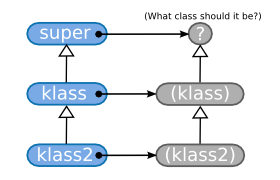
Figure 5: Hierarchy of multi-level inheritance
As the relationship between super and klass is the same as the one
between klass and klass2, c must be the singleton class
(super). If you continue like this, finally you’ll arrive at the
conclusion that Object’s class must be (Object). And that’s the
case in practice. For example, by inheriting like in the following
program :
class A < Object end class B < A end
internally, a structure like figure 6 is created.
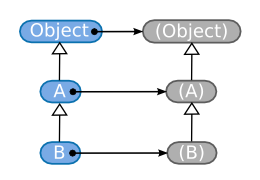
Figure 6: Class hierarchy and metaclasses
As classes and their metaclasses are linked and inherit like this, class methods are inherited.
You’ve understood the working of class methods inheritance, but by doing that, in the opposite some questions have appeared. What is the class of a class’s singleton class? To do this we can try debugging. I’ve made the figure 7 from the results of this investigation.
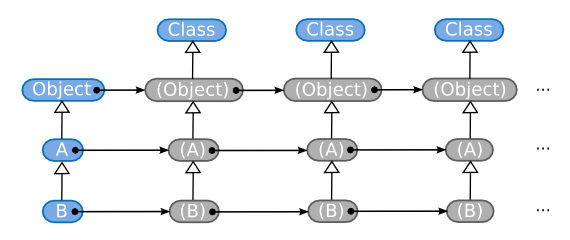
Figure 7: Class of a class’s singleton class
A class’s singleton class puts itself as its own class. Quite complicated.
The second question: the class of Object must be Class. Didn’t I
properly confirm this in chapter 1: Ruby language minimum?
p(Object.class()) # Class
Certainly, that’s the case “at the Ruby level”. But “at the C level”,
it’s the singleton class (Object). If (Object) does not appear at
the Ruby level, it’s because Object#class skips the singleton
classes. Let’s look at the body of the method, rb_obj_class() to
confirm that.
rb_obj_class()
86 VALUE
87 rb_obj_class(obj)
88 VALUE obj;
89 {
90 return rb_class_real(CLASS_OF(obj));
91 }
76 VALUE
77 rb_class_real(cl)
78 VALUE cl;
79 {
80 while (FL_TEST(cl, FL_SINGLETON) || TYPE(cl) == T_ICLASS) {
81 cl = RCLASS(cl)->super;
82 }
83 return cl;
84 }
(object.c)
CLASS_OF(obj) returns the basic.klass of obj. While in
rb_class_real(), all singleton classes are skipped (advancing
towards the superclass). In the first place, singleton class are
caught between a class and its superclass, like a proxy. That’s why
when a “real” class is necessary, we have to follow the superclass
chain (figure 8).
I_CLASS will appear later when we will talk about include.
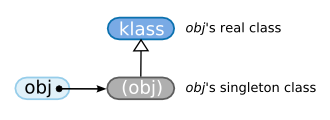
Figure 8: Singleton class and real class
Well, the singleton classes that were introduced in classes is also one type of class, it’s a class’s class. So it can be called metaclass.
However, you should be wary of the fact that singleton class are not metaclasses. It’s the singleton classes introduced in classes that are metaclasses. The important fact is not that they are singleton classes, but that they are the classes of classes. I was stuck on this point when I started learning Ruby. As I may not be the only one, I would like to make this clear.
Thinking about this, the rb_make_metaclass() function name is not
very good. When used in classes, it does indeed create a metaclass,
but not in the other cases, when using objects.
Then finally, even if you understood that some class are metaclasses, it’s not as if there was any concrete gain. I’d like you not to care too much about it.
We have nearly finished our talk about classes and metaclasses. But
there is still one problem left. It’s about the 3 metaobjects
Object, Module and Class. These 3 cannot be created with the
common use API. To make a class, its metaclass must be built, but like
we saw some time ago, the metaclass’s superclass is Class. However,
as Class has not been created yet, the metaclass cannot be build. So
in ruby, only these 3 classes’s creation is handled specially.
Then let’s look at the code:
▼Object, Module and Class creation
1243 rb_cObject = boot_defclass("Object", 0);
1244 rb_cModule = boot_defclass("Module", rb_cObject);
1245 rb_cClass = boot_defclass("Class", rb_cModule);
1246
1247 metaclass = rb_make_metaclass(rb_cObject, rb_cClass);
1248 metaclass = rb_make_metaclass(rb_cModule, metaclass);
1249 metaclass = rb_make_metaclass(rb_cClass, metaclass);
(object.c)
First, in the first half, boot_defclass() is similar to
rb_class_boot(), it just creates a class with its given superclass
set. These links give us something like the left part of figure 9.
And in the three lines of the second half, (Object), (Module) and
(Class) are created and set (right figure 9). (Object) and
(Module)’s classes… that is themselves… is already set in
rb_make_metaclass() so there is no problem. With this, the
metaobjects’ bootstrap is finished.
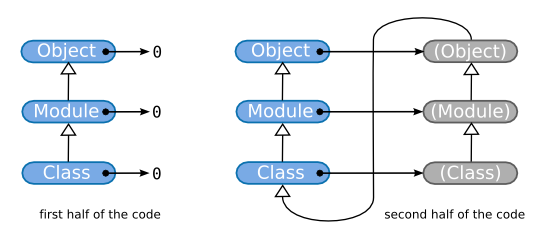
Figure 9: Metaobjects creation
After taking everything into account, it gives us a the final shape like figure 10.
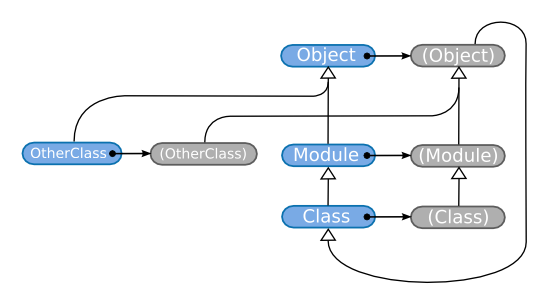
Figure 10: Ruby metaobjects
In this section, we will analyse how’s formed the reciprocal
conversion between class and class names, in other words
constants. Concretely, we will target rb_define_class() and
rb_define_class_under().
First we’ll read rb_defined_class(). After the end of this function,
the class can be found from the constant.
rb_define_class()
183 VALUE
184 rb_define_class(name, super)
185 const char *name;
186 VALUE super;
187 {
188 VALUE klass;
189 ID id;
190
191 id = rb_intern(name);
192 if (rb_autoload_defined(id)) { /* (A) autoload */
193 rb_autoload_load(id);
194 }
195 if (rb_const_defined(rb_cObject, id)) { /* (B) rb_const_defined */
196 klass = rb_const_get(rb_cObject, id); /* (C) rb_const_get */
197 if (TYPE(klass) != T_CLASS) {
198 rb_raise(rb_eTypeError, "%s is not a class", name);
199 } /* (D) rb_class_real */
200 if (rb_class_real(RCLASS(klass)->super) != super) {
201 rb_name_error(id, "%s is already defined", name);
202 }
203 return klass;
204 }
205 if (!super) {
206 rb_warn("no super class for '%s', Object assumed", name);
207 }
208 klass = rb_define_class_id(id, super);
209 rb_class_inherited(super, klass);
210 st_add_direct(rb_class_tbl, id, klass);
211
212 return klass;
213 }
(class.c)
Many things can be understood with what’s before and after
rb_define_class_id()... Before we acquire or create the class. After
we set the constant. We will look at it in more detail below.
(A) In Ruby, there is an autoload function that automatically loads
libraries when some constants are accessed. This is done in the
rb_autoload_xxxx() function. You can ignore it without any problem.
(B) We determine whether the name constant has been defined or not
in Object.
(C) Get the value of the name constant. This will be explained in
detail in chapter 6.
(D) We’ve seen rb_class_real() some time ago. If the class c is a
singleton class or an ICLASS, it climbs the super hierarchy up to
a class that is not and returns it. In short, this function skips the
virtual classes that should not appear at the Ruby level.
That’s what we can read nearby.
As around constants are involved, it is very troublesome. However, we will talk about class definition in the constants chapter so for the moment we will content ourselves with a partial description.
After rb_define_class_id, we can find the following:
st_add_direct(rb_class_tbl, id, klass);
This part assigns the class to the constant. However, whichever the
way you look at it you do not see that. In fact, top-level classes are
separated from the other constants and regrouped in
rb_class_tbl(). The split is slightly related to the GC. It’s not
essential.
We understood how the class can be obtained from the class name, but
how to do the opposite? By doing things like calling p or
Class#name, we can get the name of the class, but how is it
implemented?
In fact this was already done a long time ago by
rb_name_class(). The call is around the following:
rb_define_class
rb_define_class_id
rb_name_class
Let’s look at its content:
▼rb_name_class()
269 void
270 rb_name_class(klass, id)
271 VALUE klass;
272 ID id;
273 {
274 rb_iv_set(klass, "__classid__", ID2SYM(id));
275 }
(variable.c)
__classid__ is another instance variable that can’t be seen from
Ruby. As only VALUEs can be put in the instance variable table, the
ID is converted to Symbol using ID2SYM().
That’s how we are able to find the constant name from the class.
So, in the case of classes defined at the top-level, we know how works
the reciprocal link between name and class. What’s left is the case of
classes defined in modules or other classes, and for that it’s a
little more complicated. The function to define these nested classes
is rb_define_class_under().
rb_define_class_under()
215 VALUE
216 rb_define_class_under(outer, name, super)
217 VALUE outer;
218 const char *name;
219 VALUE super;
220 {
221 VALUE klass;
222 ID id;
223
224 id = rb_intern(name);
225 if (rb_const_defined_at(outer, id)) {
226 klass = rb_const_get(outer, id);
227 if (TYPE(klass) != T_CLASS) {
228 rb_raise(rb_eTypeError, "%s is not a class", name);
229 }
230 if (rb_class_real(RCLASS(klass)->super) != super) {
231 rb_name_error(id, "%s is already defined", name);
232 }
233 return klass;
234 }
235 if (!super) {
236 rb_warn("no super class for '%s::%s', Object assumed",
237 rb_class2name(outer), name);
238 }
239 klass = rb_define_class_id(id, super);
240 rb_set_class_path(klass, outer, name);
241 rb_class_inherited(super, klass);
242 rb_const_set(outer, id, klass);
243
244 return klass;
245 }
(class.c)
The structure is like the one of rb_define_class(): before the call
to rb_define_class_id() is the redefinition check, after is the
creation of the reciprocal link between constant and class. The first
half is pretty boringly similar to rb_define_class() so we’ll skip
it. In the second half, rb_set_class() is new. We’re going to look
at it.
rb_set_class_path()This function gives the name name to the class klass nested in the
class under. “class path” means a name including all the nesting
information starting from top-level, for example
“Net::NetPrivate::Socket”.
rb_set_class_path()
210 void
211 rb_set_class_path(klass, under, name)
212 VALUE klass, under;
213 const char *name;
214 {
215 VALUE str;
216
217 if (under == rb_cObject) {
/* defined at top-level */
218 str = rb_str_new2(name); /* create a Ruby string from name */
219 }
220 else {
/* nested constant */
221 str = rb_str_dup(rb_class_path(under)); /* copy the return value */
222 rb_str_cat2(str, "::"); /* concatenate "::" */
223 rb_str_cat2(str, name); /* concatenate name */
224 }
225 rb_iv_set(klass, "__classpath__", str);
226 }
(variable.c)
Everything except the last line is the construction of the class path,
and the last line makes the class remember its own
name. __classpath__ is of course another instance variable that
can’t be seen from a Ruby program. In rb_name_class() there was
__classid__, but id is different because it does not include
nesting information (look at the table below).
__classpath__ Net::NetPrivate::Socket __classid__ Socket
It means classes defined for example in rb_defined_class() all have
__classid__ or __classpath__ defined. So to find under’s
classpath we can look up in these instance variables. This is done by
rb_class_path(). We’ll omit its content.
Contrary to what I have just said, there are in fact cases in which
neither __classpath__ nor __classid__ are set. That is because in
Ruby you can use a method like the following to create a class.
c = Class.new()
If you create a class like this, we won’t go through
rb_define_class_id() and the classpath won’t be set. In this case,
c does not have any name, which is to say we get an unnamed class.
However, if later it’s assigned into a constant, the name of this constant will be attached to the class.
SomeClass = c # the class name is SomeClass
Strictly speaking, the name is attached after the assignment, the
first time it is requested. For instance, when calling p on this
SomeClass class or when calling the Class#name method. When doing
this, a value equal to the class is searched in rb_class_tbl, and a
name has to be chosen. The following case can also happen:
class A
class B
C = tmp = Class.new()
p(tmp) # here we search for the name
end
end
so in the worst case we have to search for the whole constant space. However, generally, there aren’t many constants so searching all constants does not take too much time.
We only talked about classes so let’s finish this chapter with something else and talk about module inclusion.
rb_include_module (1)Includes are done by the ordinary method Module#include. Its
corresponding function in C is rb_include_module(). In fact, to be
precise, its body is rb_mod_include(), and there
Module#append_feature is called, and this function’s default
implementation finally calls rb_include_module(). Mixing what’s
happening in Ruby and C gives us the following call graph.
Module#include (rb_mod_include)
Module#append_features (rb_mod_append_features)
rb_include_module
All usual includes are done by rb_include_module(). This function is
a little long so we’ll look at it a half at a time.
rb_include_module (first half)
/* include module in class */
347 void
348 rb_include_module(klass, module)
349 VALUE klass, module;
350 {
351 VALUE p, c;
352 int changed = 0;
353
354 rb_frozen_class_p(klass);
355 if (!OBJ_TAINTED(klass)) {
356 rb_secure(4);
357 }
358
359 if (NIL_P(module)) return;
360 if (klass == module) return;
361
362 switch (TYPE(module)) {
363 case T_MODULE:
364 case T_CLASS:
365 case T_ICLASS:
366 break;
367 default:
368 Check_Type(module, T_MODULE);
369 }
(class.c)
For the moment it’s only security and type checking, therefore we can ignore it. The process itself is below:
▼rb_include_module (second half)
371 OBJ_INFECT(klass, module);
372 c = klass;
373 while (module) {
374 int superclass_seen = Qfalse;
375
376 if (RCLASS(klass)->m_tbl == RCLASS(module)->m_tbl)
377 rb_raise(rb_eArgError, "cyclic include detected");
378 /* (A) skip if the superclass already includes module */
379 for (p = RCLASS(klass)->super; p; p = RCLASS(p)->super) {
380 switch (BUILTIN_TYPE(p)) {
381 case T_ICLASS:
382 if (RCLASS(p)->m_tbl == RCLASS(module)->m_tbl) {
383 if (!superclass_seen) {
384 c = p; /* move the insertion point */
385 }
386 goto skip;
387 }
388 break;
389 case T_CLASS:
390 superclass_seen = Qtrue;
391 break;
392 }
393 }
394 c = RCLASS(c)->super =
include_class_new(module, RCLASS(c)->super);
395 changed = 1;
396 skip:
397 module = RCLASS(module)->super;
398 }
399 if (changed) rb_clear_cache();
400 }
(class.c)
First, what the (A) block does is written in the comment. It seems to be a special condition so let’s first skip reading it for now. By extracting the important parts from the rest we get the following:
c = klass;
while (module) {
c = RCLASS(c)->super = include_class_new(module, RCLASS(c)->super);
module = RCLASS(module)->super;
}
In other words, it’s a repetition of module’s super. What is in
module’s super must be a module included by module (because our
intuition tells us so). Then the superclass of the class where the
inclusion occurs is replaced with something. We do not understand much
what, but at the moment I saw that I felt “Ah, doesn’t this look the
addition of elements to a list (like LISP’s cons)?” and it suddenly
make the story faster. In other words it’s the following form:
list = new(item, list)
Thinking about this, it seems we can expect that module is inserted
between c and c->super. If it’s like this, it fits module’s
specification.
But to be sure of this we have to look at include_class_new().
include_class_new()include_class_new()
319 static VALUE
320 include_class_new(module, super)
321 VALUE module, super;
322 {
323 NEWOBJ(klass, struct RClass); /* (A) */
324 OBJSETUP(klass, rb_cClass, T_ICLASS);
325
326 if (BUILTIN_TYPE(module) == T_ICLASS) {
327 module = RBASIC(module)->klass;
328 }
329 if (!RCLASS(module)->iv_tbl) {
330 RCLASS(module)->iv_tbl = st_init_numtable();
331 }
332 klass->iv_tbl = RCLASS(module)->iv_tbl; /* (B) */
333 klass->m_tbl = RCLASS(module)->m_tbl;
334 klass->super = super; /* (C) */
335 if (TYPE(module) == T_ICLASS) { /* (D) */
336 RBASIC(klass)->klass = RBASIC(module)->klass; /* (D-1) */
337 }
338 else {
339 RBASIC(klass)->klass = module; /* (D-2) */
340 }
341 OBJ_INFECT(klass, module);
342 OBJ_INFECT(klass, super);
343
344 return (VALUE)klass;
345 }
(class.c)
We’re lucky there’s nothing we do not know.
(A) First create a new class.
(B) Transplant module’s instance variable and method tables into
this class.
(C) Make the including class’s superclass (super) the super class of
this new class.
In other words, this function creates an include class for the module. The important point is that at (B) only the pointer is moved on, without duplicating the table. Later, if a method is added, the module’s body and the include class will still have exactly the same methods (figure 11).
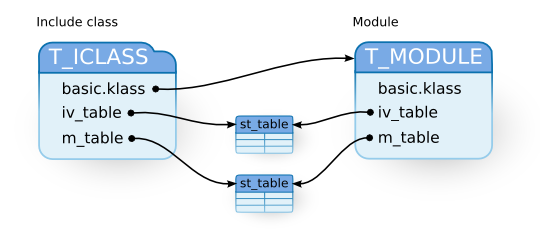
Figure 11: Include class
If you look closely at (A), the structure type flag is set to
T_ICLASS. This seems to be the mark of an include class. This
function’s name is include_class_new() so ICLASS’s I must be
include.
And if you think about joining what this function and
rb_include_module() do, we know that our previous expectations were not
wrong. In brief, including is inserting the include class of a
module between a class and its superclass (figure 12).
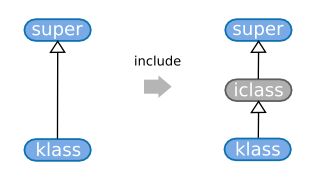
Figure 12: Include
At (D-2) the module is stored in the include class’s klass. At
(D-1), the module’s body is taken out… at least that’s what I’d like
to say, but in fact this check does not have any use. The T_ICLASS
check is already done at the beginning of this function, so when
arriving here there can’t still be a T_ICLASS. Modification to
ruby piled up at a fast pace during quite a long period of time so
there are quite a few small overlooks.
There is one more thing to consider. Somehow the include class’s
basic.klass is only used to point to the module’s body, so for
example calling a method on the include class would be very bad. So
include classes must not be seen from Ruby programs. And in
practice all methods skip include classes, with no exception.
It was complicated so let’s look at a concrete example. I’d like you
to look at figure 13 (1). We have the c1 class and the m1 module
that includes m2. From there, the changes made to include m1 in
c1 are (2) and (3). ims are of course include classes.
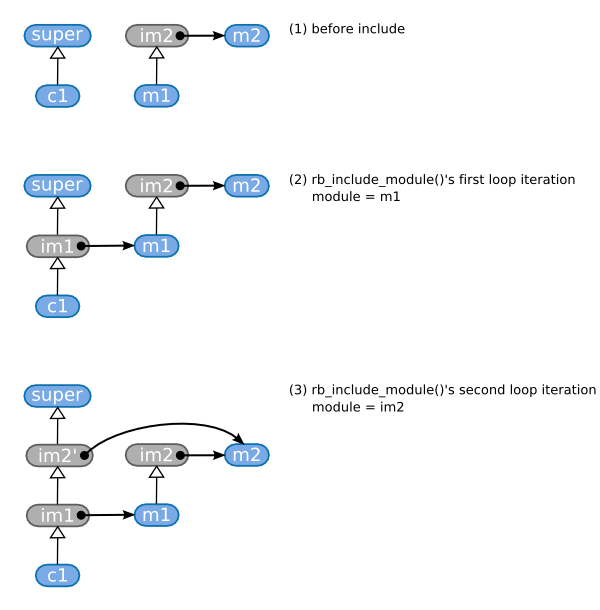
Figure 13: Include
rb_include_module (2)Well, now we can explain the part of rb_include_module() we skipped.
rb_include_module (avoiding double inclusion)
378 /* (A) skip if the superclass already includes module */
379 for (p = RCLASS(klass)->super; p; p = RCLASS(p)->super) {
380 switch (BUILTIN_TYPE(p)) {
381 case T_ICLASS:
382 if (RCLASS(p)->m_tbl == RCLASS(module)->m_tbl) {
383 if (!superclass_seen) {
384 c = p; /* the inserting point is moved */
385 }
386 goto skip;
387 }
388 break;
389 case T_CLASS:
390 superclass_seen = Qtrue;
391 break;
392 }
393 }
(class.c)
If one of the T_ICLASSes (include classes) that are in klass’s
superclasses (p) has the same table as one of the modules we want to
include (module), it’s an include class for module. That’s why we
skip the inclusion to not include the module twice. If this module
includes an other module (module->super), we check this once more.
However, when we skip an inclusion, p is a module that has been
included once, so its included modules must already be
included… that’s what I thought for a moment, but we can have the
following context:
module M end module M2 end class C include M # M2 is not yet included in M end # therefore M2 is not in C's superclasses module M include M2 # as there M2 is included in M, end class C include M # I would like here to only add M2 end
So on the contrary, there are cases for which include does not have
real-time repercussions.
For class inheritance, the class’s singleton methods were inherited
but in the case of module there is no such thing. Therefore the
singleton methods of the module are not inherited by the including
class (or module). When you want to also inherit singleton methods,
the usual way is to override Module#append_features.
